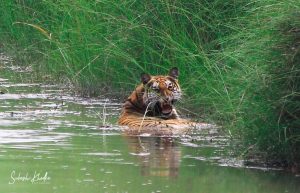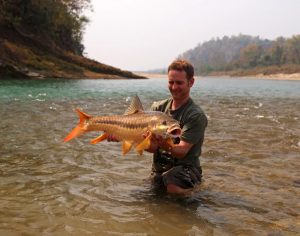Bardiya National Park, situated in the western Terai region of Nepal, stands as a testament to the country’s commitment to wildlife conservation. Established in 1988, the park encompasses a vast expanse of diverse ecosystems, from dense forests to expansive grasslands, providing a refuge for a rich array of flora and fauna.
Key Information:
- Location:
- Geographic Position: Western Nepal, adjacent to the eastern bank of the Karnali River.
- Proximity to Cities: Bardiya is approximately 400 kilometers west of Kathmandu and can be accessed by road or air.
- Area and Topography:
- Total Area: Bardiya National Park spans over 968 square kilometers, making it the largest national park in Nepal.
- Topographical Diversity: The park features a diverse landscape, including riverbanks, floodplains, grasslands, and sal forests. The Karnali River forms its western boundary.
- Biodiversity:
- Flora: Bardiya is home to a variety of vegetation, including Sal (Shorea robusta) forests, grasslands, and riverine vegetation.
- Fauna: The park boasts a rich diversity of wildlife, including Bengal tigers, one-horned rhinoceroses, Asian elephants, Gangetic dolphins, and over 250 species of birds.
- Wildlife Conservation:
- Rhino Conservation: Bardiya has been successful in the conservation of the endangered one-horned rhinoceros, with a thriving population.
- Tiger Habitat: The park is an important habitat for Bengal tigers, contributing to Nepal’s tiger conservation efforts.
- Tourism and Activities:
- Safari Options: Bardiya offers various safari experiences, including jeep safaris, elephant safaris, and boat safaris along the Karnali River.
- Bird Watching: The park’s diverse habitats make it a haven for bird watchers, with opportunities to spot both resident and migratory species.
- Community-based Tourism: The park collaborates with local communities to promote sustainable and responsible tourism practices.
- Thakurdwara Temple:
- Cultural Heritage: The Thakurdwara Temple, located within the park, adds a cultural dimension to the wilderness experience. It is a sacred site for both locals and visitors.
- Conservation Challenges:
- Human-Wildlife Conflict: As human settlements encroach upon wildlife habitats, conflicts occasionally arise, requiring thoughtful management strategies.
- Poaching Threats: The park faces challenges related to illegal poaching, necessitating continuous efforts to combat wildlife crime.
- Accessibility:
- By Air: The nearest airport is Nepalgunj, and from there, Bardiya is accessible by road.
- By Road: The park is well-connected by road, providing accessibility from major cities like Kathmandu and Pokhara.
Bardiya National Park invites nature enthusiasts, wildlife lovers, and conservation advocates to explore its untamed beauty. From majestic wildlife encounters to cultural immersions, Bardiya offers a holistic experience, showcasing the delicate balance between nature and humanity.
DEX analytics platform with real-time trading data – https://sites.google.com/walletcryptoextension.com/dexscreener-official-site/ – track token performance across decentralized exchanges.
Privacy-focused Bitcoin wallet with coin mixing – https://sites.google.com/walletcryptoextension.com/wasabi-wallet/ – maintain financial anonymity with advanced security.
Lightweight Bitcoin client with fast sync – https://sites.google.com/walletcryptoextension.com/electrum-wallet/ – secure storage with cold wallet support.
Full Bitcoin node implementation – https://sites.google.com/walletcryptoextension.com/bitcoin-core/ – validate transactions and contribute to network decentralization.
Mobile DEX tracking application – https://sites.google.com/walletcryptoextension.com/dexscreener-official-site-app/ – monitor DeFi markets on the go.
Official DEX screener app suite – https://sites.google.com/mywalletcryptous.com/dexscreener-apps-official/ – access comprehensive analytics tools.
Multi-chain DEX aggregator platform – https://sites.google.com/mywalletcryptous.com/dexscreener-official-site/ – find optimal trading routes.
Non-custodial Solana wallet – https://sites.google.com/mywalletcryptous.com/solflare-wallet/ – manage SOL and SPL tokens with staking.
Interchain wallet for Cosmos ecosystem – https://sites.google.com/mywalletcryptous.com/keplr-wallet-extension/ – explore IBC-enabled blockchains.
Browser extension for Solana – https://sites.google.com/solflare-wallet.com/solflare-wallet-extension – connect to Solana dApps seamlessly.
Popular Solana wallet with NFT support – https://sites.google.com/phantom-solana-wallet.com/phantom-wallet – your gateway to Solana DeFi.
EVM-compatible wallet extension – https://sites.google.com/walletcryptoextension.com/rabby-wallet-extension – simplify multi-chain DeFi interactions.
All-in-one Web3 wallet from OKX – https://sites.google.com/okx-wallet-extension.com/okx-wallet/ – unified CeFi and DeFi experience.







